Datafrac testing and mini-falloff analysis aided in the design of frac jobs to produce gas from shale in a field with well-established conventional oil production.
Shyam Sundar Sharma, P. K. Kulkarni and Anil Kumar, Joshi Technologies International; Piyush Pankaj, Venkateshwaran Ramanathan and Pande Susanta, Schlumberger
The Cambay Basin of India’s Gujarat state is primarily being explored and developed for conventional oil and gas. However, given India’s ever-increasing energy demand, operators in the region are in search of the right tool to tap its unconventional resources as well. A major first step in this direction was the recent successful production of shale gas from Dholka Field, enabled by the design and execution of an effective hydraulic fracture treatment. This effort resulted in the first-ever commercial exploitation of shale gas reserves in India.
Dholka is a small field producing mainly oil from upper, middle and lower pay zones. However, during the development phase, mud logging of a well operated by Joshi Technologies in the field found interlaying shale above the upper pay zone showing a significant amount of light hydrocarbon components. Gas content was estimated at about 24%, so the well was considered a potential source of gas pay that could be exploited using hydraulic fracturing. This was the first well in the field to encounter shale gas characteristics. Lithofacies and petrographic studies of the cuttings confirmed that more than 50% of the facies are shale.
To assess the maximum potential of the two hydrocarbon-bearing shale intervals, it was decided to frac each of these intervals separately. Planning and design led to a successful frac job, and based on the encouraging results, another well was similarly fraced as a pilot test to explore shale gas in the area. Lessons learned from this project led the operator to consider the encountered shale intervals for further detailed exploration and development.
DISCOVERING THE GAS
Spread over an area of about 20,700 sq mi, the Cambay Basin extends north into Rajasthan state and south and southwest into the shelf of the Arabian Sea through the Gulf of Cambay, Fig. 1. Initial oil in place estimated at 1,150 million tonnes makes the Cambay Basin the largest onshore hydrocarbon basin in India. More than 5,000 wells have been drilled to extract oil and gas from the numerous fields scattered in the basin. Geologically, the basin is an intra-cratonic graben flanked on the east and the west by fairly wide shelves dipping toward the center of the graben. The basin can be broadly divided into five major tectonic blocks: Sanchor-Patan, Ahmedabad-Mehsana, Tarapur, Bharuch and Narmada. Dholka is a high-potential oil field in the Tarapur Block, mainly producing conventional oil and gas.
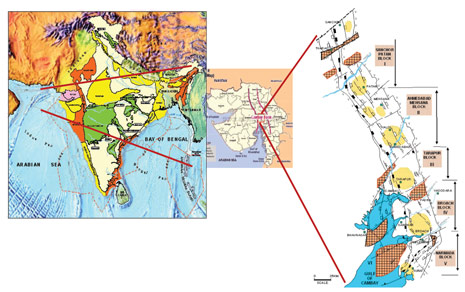 |
|
Fig. 1. Location map of the Cambay Basin.
|
|
The field is a doubly plunging faulted anticline, trending NNE–SSW. The basement is encountered at about 6,920 ft. The reservoir rocks comprising mostly silty sandstones occur between 4,430 ft and 5,740 ft in the Lower to Middle Eocene section. The hydrocarbon accumulation is in bars and channels whose geometry and continuity are very difficult to demarcate. There are 13 sublayers, each 10–23 ft thick, which are grouped into lower, middle and upper pay sections. The source rock is both old and young Cambay Shale with thickness of 3,000–4,000 ft. While drilling the Cambay Shale section, gas shows, kicks, trip gas and gas-cut mud were common occurrences, strongly indicating the possibility that shale gas and/or oil could be produced from the Cambay Shale.
In the northern part of Dholka Field, exploratory/development Well D-A was drilled to target the lower and middle pays. The mud log showed possible shale gas at a depth of 4,290–4,320 ft. Cuttings from this section were light greenish gray, moderately indurated, fissile, feebly calcareous with specs of chlorite flakes, carbonaceous and sideritic in nature. The bulk mineralogy was in decreasing proportion of quartz, siderite, kaolinite and calcite. As observed on the mud log, C1 and C2 totaled about 24% of hydrocarbon composition, indicating a potential gas-producing shale pay that could be efficiently exploited using hydraulic fracturing.
EXPLORATION METHODOLOGY
The shale gas exploration workflow typically starts with observation of gas in the cuttings with mud. Understanding the extent of shale gas pay with the help of pilot wells, seismic interpretation and log correlation is important. Quantifying the gas as free gas present in the natural fractures, fissures and pore spaces along with the adsorbed gas helps evaluate the potential of the field for economic viability. This can be done by shale gas adsorption-desorption studies on the cores to measure the Langmuir volume (i.e., the maximum amount of gas that can be adsorbed at infinite pressure) and gas content with change in pore pressure.
Petrophysical evaluation and reservoir characterization from the backbone of evaluating a shale gas pay. Advanced openhole logging suites, coring methodology, elemental spectroscopy and lithology identification are imperative for estimating the total organic content (TOC) and evaluate the shale gas production potential. It also helps to understand the mineralogy in order to select the correct fracturing fluid for maximizing production. Core testing and evaluation play a crucial role in validating the petrophysical and geological analysis. Since shales are extremely anisotropic and heterogenous, this validation is needed so the “sweet spots” can be determined and completed. Finally, the isotherms that are developed will help in determining commercial producibility. Geomechanical analysis—understanding the stress regime—helps in design of the horizontal well plan, completion, perforation strategy and fracture geometry. Microseismic fracture monitoring is useful in designing the fracturing stages for zonal coverage. The data gathered throughout this process can be used to predict shale gas production performance using numerical reservoir simulators.
Since in Wells D-A, drilled in 2009, and D-B, drilled in 1989, the primary focus during the drilling phase was to produce oil from the lower pay, this detailed workflow for shale gas exploration was not incorporated. Based on the encouraging shale gas signature in Well D-A’s drilled cuttings and similar log signatures in D-B, a pilot project was executed to test the production potential of the shallow shale pays in the two wells using hydraulic fracturing.
FRACING APPLICATION
Since the wells were not drilled as shale gas wells, it was decided based on both technical and economic criteria to fracture them conventionally with crosslinked guar gel. The primary objective of the stimulation exercise was to evaluate the gas flow potential to the surface from the shale pay zone. With only limited data available, optimization was not the guiding force behind the treatment. Based on swelling properties of the shale, a 4% KCl solution was used as the baseline fluid for the treatment. Fracture execution was carried out after or datafrac testing and mini-falloff analysis. The method involves the execution of a short-duration, small-volume fracturing operation where a small amount of fluid is pumped until fracture initiation. At that point, the wing or frac valve is closed, allowing the well’s pressure to fall off naturally over the course of 24–48 hours or longer.
The datafrac treatment used at Dholka Field consisted of two parts, a step-rate injectivity test and a calibration test, both of which were followed by pressure decline analysis to help estimate vital design parameters for the main job. The injectivity test is performed with a non-viscous (typically brine) fluid to provide an initial estimate of closure and near-wellbore pressure losses. The pressure decline analysis for this test helps to estimate reservoir pressure and reservoir fluid transmissibility.
Following this, a calibration injection test was performed by pumping the main frac fluid that was planned for use in the main fracturing treatment job. The pressure decline analysis for this test helps to estimate closure pressure, fracture geometry, frac fluid leakoff coefficients and fluid efficiency, based on which re-design adjustments can be made for the main job if required.
Well D-A execution. Well D-A is a vertical well drilled to a depth of about 5,870 ft. The well was completed with a 5½-in., 17-lb/ft casing and 2⅞-in. workstring. The main target for this well spanned the lower pay and the upper pay. However shale was encountered while drilling at a depth of about 4,300 ft, about 90 ft above the upper pay section. To explore the gas production potential of this shale section, a hydraulic fracturing treatment was designed. The permeability of the shale was expected to be less than 1 mD with average porosity of 8%. Reservoir pressure and temperature was 3,100 psia and 215°F, respectively.
Datafrac was carried out on this well to estimate fracture closure pressure, fluid efficiency, near-wellbore friction and non-ideal fluid leakoff behavior, Fig. 2. Mini-falloff analysis was performed on the injection decline after the step-rate injectivity test to determine the reservoir pressure and transmissibility. Rock cutting analysis in presence of brine was performed, and 4% KCl brine was used as the base for preparation of the crosslinked fracturing fluid.
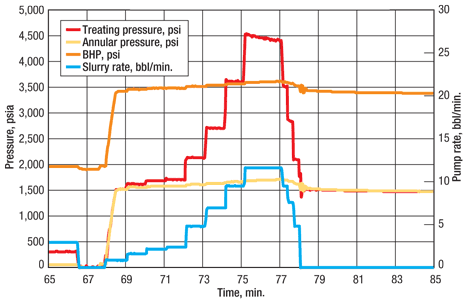 |
|
Fig. 2. Well D-A step-rate injectivity test.
|
|
Low transmissibility of 182 mD-ft was measured, yielding a corresponding permeability estimate of 0.13 mD in the shale pay. The presence of multiple closures and fissures was also observed. The reservoir pressure measured from the mini-falloff analysis was 3,078 psia. The closure pressure was estimated to be 3,416 psia, yielding a frac gradient of 0.79 psi/ft.
The calibration injection then followed (Fig. 3), and a frac fluid efficiency of 48% was observed. This relatively low fluid efficiency can be attributed to the fact that the shale section is only about 20 ft thick, and penetration of the viscous gelled fluid into the silty sandstones reduces the overall fluid efficiency.
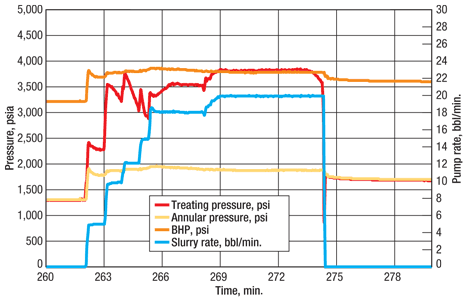 |
|
Fig. 3. Well D-A calibration injection test.
|
|
Based on the datafrac testing, the main frac job was designed, Fig. 4. The well’s live annulus facilitated measurement of real-time bottomhole pressures and allowed the completion engineers to make on-the-fly changes during the pumping operation.
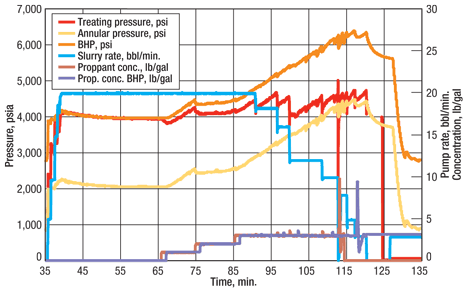 |
|
Fig. 4. Well D-A main frac treatment.
|
|
Well D-B execution. Well D-B is a relatively old vertical well drilled in 1989 to a depth of about 6,030 ft. Like Well D-A, it was completed with a 5½-in., 17-lb/ft casing and 2⅞-in. workstring. The well had targeted the lower pay for oil production, but productivity had slowly declined until becoming uneconomic. Since shale of similar log characteristics to those in Well D-A was also encountered in this well while drilling at a depth of about 4,300 ft, the successful hydrofracturing of Well D-A encouraged the operator to also explore the gas production potential of Well D-B’s shale section using hydraulic fracturing. The shale permeability was expected to be less than 1 mD, and reservoir pressure and temperature were 3,100 psia and 217°F, respectively.
Datafrac was carried out on this well to estimate fracture closure pressure, fluid efficiency, near-wellbore friction and non-ideal fluid leakoff behavior, Fig. 5. Mini-falloff analysis was performed on the injection pressure decline after the step-rate injectivity test to determine the reservoir pressure and transmissibility. Similar to Well D-A, a 4% KCl brine was used as the base for preparation of the crosslinked fracturing fluid.
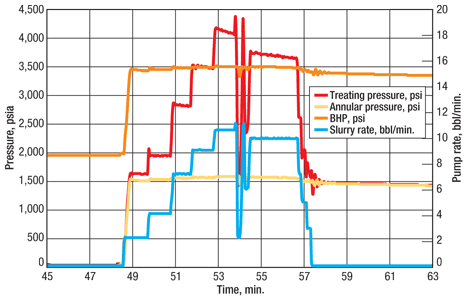 |
|
Fig. 5. Well D-B calibration injection test.
|
|
Transmissibility of 1,696 mD-ft was measured, corresponding to an estimated permeability at 0.86 mD in the shale pay. The presence of multiple closures and fissures was also observed. The reservoir pressure measured from the mini-falloff analysis was 3,208 psia. An estimated closure pressure of 3,337 psia yielded a fracture gradient of 0.76 psi/ft.
The calibration injection was then performed (Fig. 6), and a frac fluid efficiency of 45% was observed. As in Well D-A, this relatively low fluid efficiency was attributed to the thinness of the shale section (only about 13 ft) and the penetration of the viscous gelled fluid into adjacent silty sandstones.
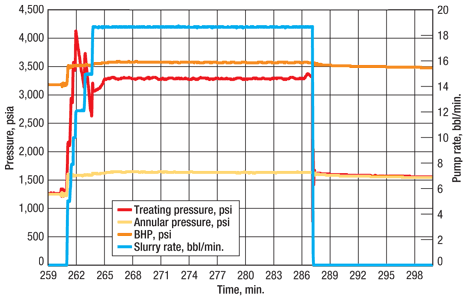 |
|
Fig. 6. Well D-B calibration injection test.
|
|
The main frac job was designed based on the results of datafrac testing, Fig. 7. Once again, the well’s live annulus facilitated the measurement of real-time bottomhole pressures and allowed design changes to be made on the fly while pumping. At 18 bbl/min., a total of 150,000 lb of proppant was pumped during the job. Table 1 summarizes the main fracture treatments for both wells.
| TABLE 1. Main frac treatment for Wells D-A and D-B |
 |
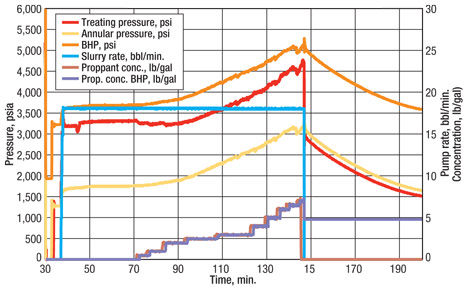 |
|
Fig. 7. Well D-B main frac treatment.
|
|
RESULTS
After hydraulic fracturing, the frac fluid flowback and gas production rate on these wells were closely monitored. Gas samples were collected, and compositional analysis was performed. In Well D-A, after sustained stabilized production of the shale gas, the upper pay was also opened to produce both oil and shale gas. In turn, the shale gas helped to lighten the crude oil from the upper pay and assist in lift. Composition and calorific analysis of the shale gas in Wells D-A and D-B is tabulated in Table 2.
| TABLE 2. Shale gas composition analysis |
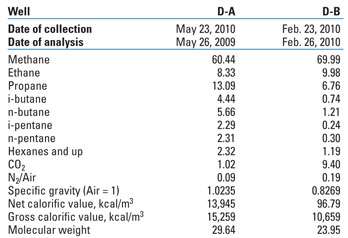 |
Before hydraulic fracturing, Well D-A had not demonstrated production of any oil from the shale section. However, after the frac job, the shale pay in Well D-A is producing at stabilized rates of about 11 Mcfd of gas and 13 bopd.
In Well D-B, the newly completed and hydrofractured shale pay is producing at stabilized rates of 21 Mcfd and 13 bopd.
CONCLUSIONS
The primary objective of flowing shale gas from the Cambay Shale was achieved by a successful hydraulic fracture execution. Wells D-A and D-B have been continuously producing both oil and gas from shale pay since being hydraulically fractured, marking the first execution of hydraulic fracturing to produce shale gas in India. The methodology used to design and execute these frac jobs can be applied on a larger scale to unlock the region’s shale gas reserves with optimized completions. Reservoir characterization and detailed planning using the shale gas exploration workflow methodology are necessary to build on this success. 
ACKNOWLEDGMENTS
This article was prepared from IADC/SPE 135664 presented at the IADC/SPE Asia Pacific Drilling Technology Conference and Exhibition held in Ho Chi Minh City, Vietnam, Nov. 1–3, 2010.The authors extend their appreciation to Dr. Sadanand Joshi and the management of Joshi Technologies International Inc. and Schlumberger for their permission to present and publish these results.
BIBLIOGRAPHY
Chowdhary, L. R., Petroleum Geology of the Cambay Basin Gujarat, India, Indian Petroleum, Dehra Dun, 1990.
Ketter, A. A., Heinze, J. R., Daniels, J. L. and G. Waters, “A field study in optimizing completion strategies for fracture initiation in Barnett Shale horizontal wells,” SPE Production & Operations, 23, No. 3, August 2008, pp. 373–378.
Pankaj, P., Agarwal, D. and S. Kasturia, “Schlumberger end of well reports, JTI stimulation campaign,” Ahmedabad, 2009–2010.
Pankaj, P. and V. Kumar, “Well testing in tight gas reservoir: Today’s challenges and future’s opportunity,” SPE 129032 presented at the SPE Oil and Gas India Conference and Exhibition, Mumbai, Jan. 20–22, 2010.
Samuel, M. et al., “Viscoelastic surfactant fracturing fluids: Applications in low permeability reservoirs,” SPE 60322-MS presented at the SPE Rocky Mountain Regional/Low-Permeability Reservoirs Symposium and Exhibition, Denver Colo., March 12–15, 2000.
Sharma, S. S. and P. K. Kulkarni, “Gas strike in shale gas reservoir in Dholka Field in Cambay Basin,” SPE 129082 presented at the SPE Oil and Gas India Conference and Exhibition, Mumbai, Jan. 20–22, 2010.
|
THE AUTHORS
|
| Shyam Sunder Sharma is General Manager of Operations for Joshi Technologies International since 2007 and is responsible for production and drilling activities in India. He has 41 years’ experience in the oil industry including 38 years for India’s largest national oil company, Oil and Natural Gas Corp. (ONGC). He has extensive experience in production operations and application of stimulation technology in India’s various oil fields. He holds bachelor’s degree in mechanical engineering from Gujarat University Ahmedabad. |
|
| P. K. Kulkarni, Project Director at Joshi Technologies International since 2006, holds a post-graduate degree in geology from Osmania University Hyderabad. He has 52 years of diverse experience, including as a Senior Executive at ONGC and in board and advisory positions in private oil companies. He had intensive training in the Former Soviet Union, with Schlumberger, and associated with academic institutes in India such as the Indian School of Mines Dhanbad and Maharashtra Institute of Technology Pune. He has been actively involved in professional societies including the Society of Petroleum Engineers and India’s Society of Petroleum Geo-physicists. |
|
| Anil Kumar is a Drilling and Production Engineer for Joshi Technologies International since 2006. He is responsible for drilling and workover activities in JTI’s assets. He has also performed stimulation activities including hydraulic fracturing and acidization jobs for JTI wells. Mr. Kumar holds a degree in electronic engineering. |
|
| Piyush Pankaj is a Production Stimulation Engineer for Schlumberger with more than four years of industry experience. He holds a bachelor’s degree in petroleum engineering from the Indian School of Mines Dhanbad. He has worked in Colorado and in India and has wide experience as a lead engineer on different stimulation and production engineering projects for oil and gas wells. Currently, he works in the Schlumberger Data and Consulting services technical team and is responsible for production enhancement, hydraulic fracturing and acidization projects for all operators in western India. |
|
| Venkateshwaran Ramanathan is the Stimulation Domain Manager in India for Schlumberger and has worked for the company for 13 years. He holds a master’s degree in petroleum engineering from West Virginia University and a bachelor’s degree in chemical engineering from Annamalai University in India. He has worked in Saudi Arabia, the US and India, and has extensive experience in sandstone and carbonate stimulation. Mr. Ramanathan is currently responsible for all Schlumberger stimulation projects in India. |
|
| Pande Susanta is the Field Service Manager in India for Schlumberger coiled tubing and pumping services. He has more than 10 years of field operations experience and holds a degree in petroleum engineering from the Bandung Institute of Technology in Indonesia. He has worked for different operators in Indonesia, Libya and India on a variety of hydraulic fracturing, acidization and coiled tubing projects. Currently, he manages well services field operations for Schlumberger in India. |
|











